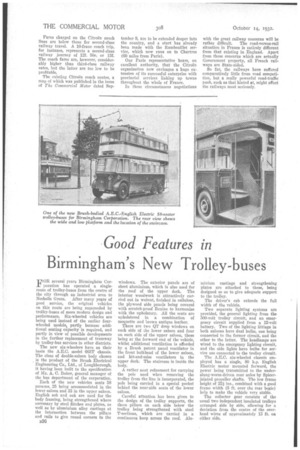Good Features in Birmingham's New Trolley-buses
Page 62

If you've noticed an error in this article please click here to report it so we can fix it.
FOR several years Birmingham Corporation has operated a singleroute of trolley-buses from the centre of the city through an industrial area to Nechells Green. After many years of good service, the original vehicles on this route are being superseded by trolley-buses of more modern design and performance. Six-wheeled vehicles are being used instead of the earlier fourwheeled models t partly because additional seating capacity is required, and partly in view of possible developments in the further replacement of tramway by trolley-bus services in other districts.
The new six-wheelers have as their basis the A.E.C. model 663T chassis. The class of double-saloon body chosen is the product of the Brush Electrical Engineering Co., Ltd., of Loughborough, it having been built to the specification of Mr. A. C. Baker, general manager of the bus department of the corporation.
Each of the new vehicles seats 58 persons, 25 being accommodated in the lower saloon and 33 in the upper saloon. English ash and oak are used for the body framing, being strengthened where necessary by steel flitches and plates, as well as by aluminium alloy castings at the intersection between the pillars and rails to give round corners to the )336 windows. The exterior panels are of sheet aluminium, which is also used for the roof of the upper deck. The interior woodwork is attractively carried out in walnut, finished in cellulose, the plywood side panels being covered with scratch-proof Rexine to harmonize with the upholstery. All the seats are upholstered in a combination of moquette and brown antique leather.
There are two QT drop windows on each side of the lower saloon and four on each side of the upper saloon, these being at the forward end of the vehicle, whilst additional ventilation is afforded by a Brush patent panel ventilator in the front bulkhead of the lower saloon, and hit-and-miss ventilators in the upper deck. The staircase is inside the body.
A rather neat refinement for carrying the pole used when removing the trolley from the line is incorporated, the pole being carried in a special pocket behind the near-side seats of the lower saloon.
Careful attention has been given to the design of the trolley supports, the three pillars on each side below the trolley being strengthened with steel T-sections, which are carried in a continuous hoop across the roof. Alu
minium castings and strengthening plates are attached to these, being designed so as to give adequate support to the trolley.
The driver's cab extends the full width of the vehicle.
Two separate lighting systems are provided, the general lighting from the 500-volt trolley circuit, and an emergency circuit supplied from a 12-volt battery. Two of the lighting fittings in both saloons have dual bulbs, one being connected to the former circuit, and the other to the latter. The headlamps are wired to the emergency lighting circuit, and the side lights have bulbs for service use connected to the trolley circuit.
The A.E.O. six-wheeled chassis employed has a single, 80 h.p. English Electric motor mounted forward, the power being transmitted to the underslung-worm-driven rear axles by Spicerjointed propeller shafts. The low frame height of 22i ins., combined with a good frame width (5 ft. over the rear bogie) help to make the vehicle very stable.
The collector gear consists of the usual two independent insulated trolleys arranged side by side, allowing for a deviation from the centre of the overhead wires of approximately 13 ft. on either side.




































































































